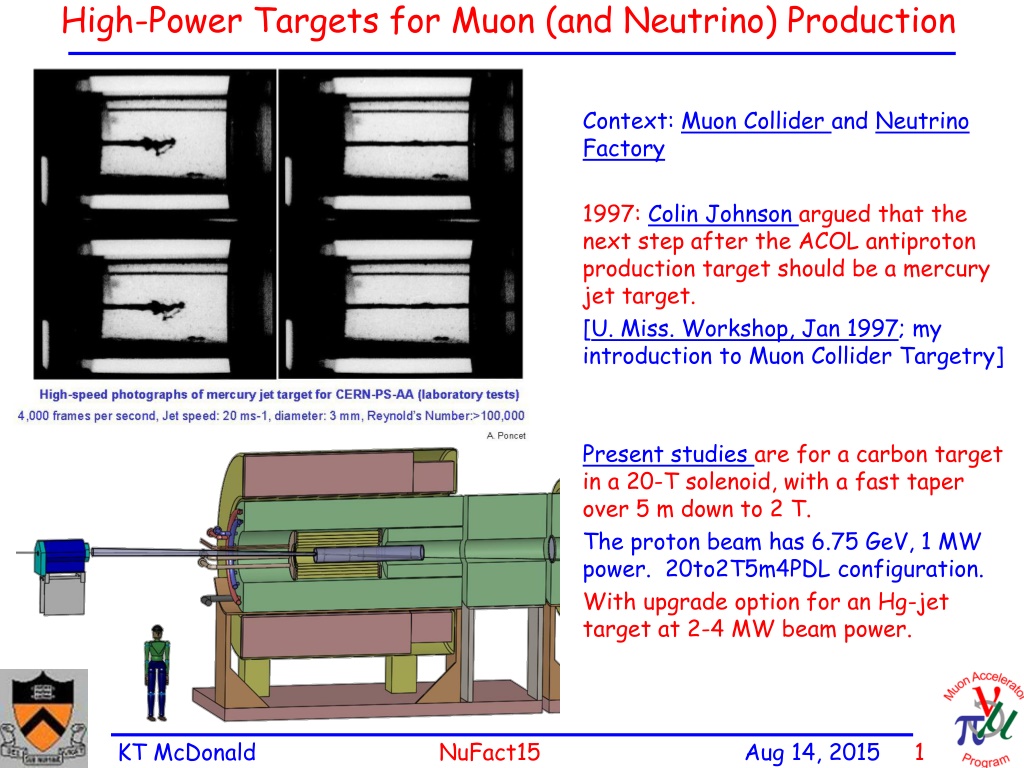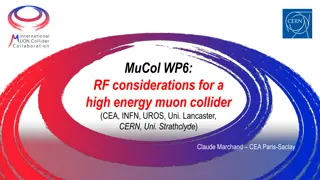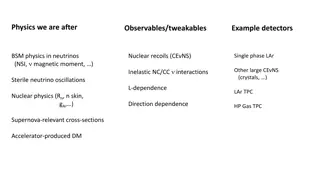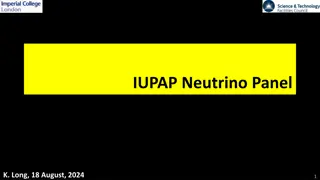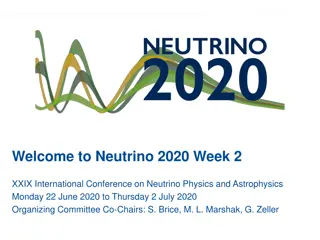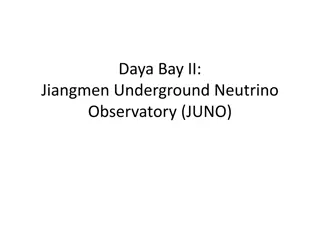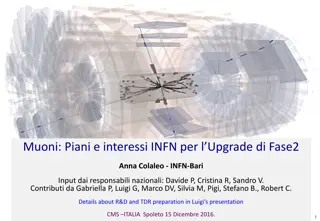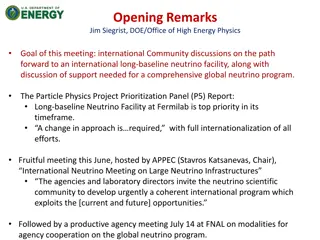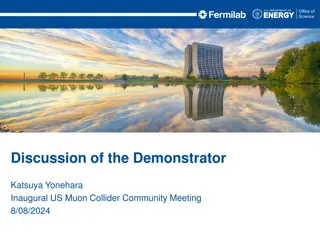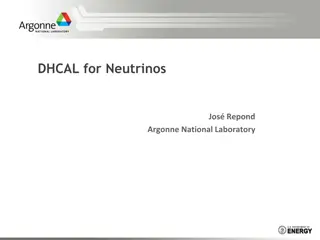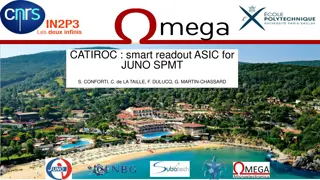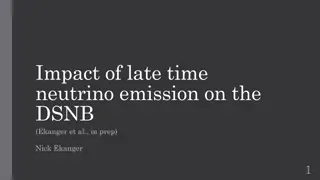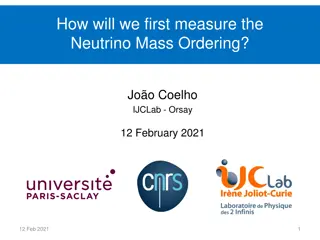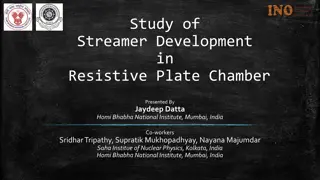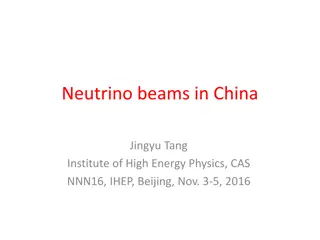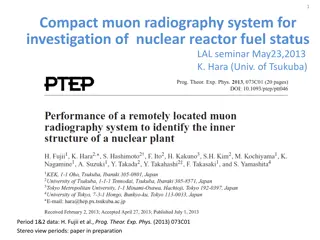High-Power Targets for Muon and Neutrino Production
Colin Johnson advocated for a mercury jet target as the next step for muon production post-ACOL. Current studies focus on a carbon target with proton beam parameters optimized for muon generation. Carlo Rubbia discussed a potential Muon-Collider Higgs Factory concept at CERN, sparking debate on muon production methods and the necessity of cooling in existing designs. Emittance considerations and the Bethe-Heitler process for muon production were analyzed, questioning the efficiency and practicality of different production techniques. The conservation of emittance density in phase volume and the invariance of rms emittance under linear transformations were also explored.
Download Presentation

Please find below an Image/Link to download the presentation.
The content on the website is provided AS IS for your information and personal use only. It may not be sold, licensed, or shared on other websites without obtaining consent from the author.If you encounter any issues during the download, it is possible that the publisher has removed the file from their server.
You are allowed to download the files provided on this website for personal or commercial use, subject to the condition that they are used lawfully. All files are the property of their respective owners.
The content on the website is provided AS IS for your information and personal use only. It may not be sold, licensed, or shared on other websites without obtaining consent from the author.
E N D
Presentation Transcript
High-Power Targets for Muon (and Neutrino) Production Context: Muon Collider and Neutrino Factory 1997: Colin Johnson argued that the next step after the ACOL antiproton production target should be a mercury jet target. [U. Miss. Workshop, Jan 1997; my introduction to Muon Collider Targetry] Present studies are for a carbon target in a 20-T solenoid, with a fast taper over 5 m down to 2 T. The proton beam has 6.75 GeV, 1 MW power. 20to2T5m4PDL configuration. With upgrade option for an Hg-jet target at 2-4 MW beam power. KT McDonald NuFact15 Aug 14, 2015 1
Are We On the Right Track? On April 14, 2015, Carlo Rubbia gave a talk on a possible Muon-Collider Higgs Factory at CERN. https://indico.cern.ch/event/383634/ During the question period, Witek Krasny claimed that present Muon Collider designs are all wrong, and the right thing to do is generate muons via the Bethe-Heitler process in -N collisions, N N + -, because the muons are produced with zero emittance, so no cooling is needed. ??????????????? The rate of Bethe-Heitler muon-pair production is only (me/m )2 ~ 1/40,000 that of electron-positron production (when well above threshold), so about 0.001 of the efficiency of muon production via p-N interactions, Need ~ 1-GW beam power to produce the same number of muons via Bethe-Heitler as via p-N interactions at 1-MW beam power. [Rubbia: The B-H scheme might not be practical.] But, if the muons are really produced with zero emittance, we wouldn t need as many muons to obtain a specified luminosity at a muon collider via the B-H process [For neutrino production, what matters is beam rate, not emittance.] However, pions produced in p-N interactions in a pencil target also have zero emittance! So, why is cooling necessary in our present designs? On April 14, 2015, Carlo Rubbia gave a talk on a possible Muon-Collider Higgs Factory at CERN. https://indico.cern.ch/event/383634/ During the question period, Witek Krasny claimed that present Muon Collider designs are all wrong, and the right thing to do is generate muons via the Bethe-Heitler process in -N collisions, N N + -, because the muons are produced with zero emittance, so no cooling is needed. ??????????????? The rate of Bethe-Heitler muon-pair production is only (me/m )2 ~ 1/40,000 that of electron-positron production (when well above threshold), so about 0.001 of the efficiency of muon production via p-N interactions, Need ~ 1-GW beam power to produce the same number of muons via Bethe-Heitler as via p-N interactions at 1-MW beam power. [Rubbia: The B-H scheme might not be practical.] But, if the muons are really produced with zero emittance, we wouldn t need as many muons to obtain a specified luminosity at a muon collider via the B-H process [For neutrino production, what matters is beam rate, not emittance.] However, pions produced in p-Ninteractions in a pencil target also have zero emittance! So, why is cooling necessary in our present designs? KT McDonald NuFact15 Aug 14, 2015 2
Theoretical and Practical Emittance Density in phase volume is conserved in Hamiltonian processes, such as particle beam transport without energy loss (Liouville s theorem). Emittance is a measure of volume in phase space, so theoretically conserved. A practical measure of emittance is its rms value, such as ( ) 123 6 123, , kl m det 6 ( ) = = = = , , , , , , , . x x x x x x q p q p q p 1 1 2 2 3 3 k l k k k k If motion in different indices i is decoupled, we consider the subemittances, ( ) det i i i i m m ( , , xy kl m 2 2 2 x p x p ( ) i i = = = = , , , , x x x q p , i kl k l k i i ) det 4 ( ) xy = = = , , , , . x x x q p q p k l k x x y y Rms emittances are actually invariant only under linear (canonical) transformations. Unfortunately, propagation of a beam across a field-free drift region is nonlinear (even though the particles move along straight lines). KT McDonald NuFact15 Aug 14, 2015 3
Solenoidal Beam Transport What about propagation in a constant (solenoidal) magnetic field? Claim: if the diameter 2c p /eBz of the helical trajectory of a charge e with transverse momentum p p in a uniform axial magnetic field Bz is less than the rms radial extent of the bunch, the bunch does not appear to grow radially as it propagates, and the rms measure of transverse emittance remains invariant with time/distance. 2 c e This stabilization of transverse emittance occurs for (JS Berg, 2013). p = B B 0 z 2 p 2 c eB The stabilized transverse emittance is . 0 If the initial beam emittance is smaller than this, it will grow to this value as the beam propagates. See slide 10 of http://www.physics.princeton.edu/~mcdonald/mumu/target/emittrans1.pdf That is, a source with zero theoretical transverse emittance quickly takes on a finite rms transverse emittance given by the above expression, which depends on the characteristic transverse momentum at the source, as well as the field strength of the solenoid magnet. Note that for a given p of the beam, use of a larger solenoid field implies smaller transverse emittance. KT McDonald NuFact15 Aug 14, 2015 4
Practical Source Emittance: p-N vs. Bethe-Heitler For a Muon Collider source based on p-N interactions, we have sought to keep 250 MeV/ . p c If we used the Bethe-Heitler process, N N + -, to avoid the threshold effect, we would need to operate with E ~ 400 MeV, such that 100 MeV/ . p m c Hence, the stabilized rms transverse emittance using a Bethe-Heitler source would be (1/2.5)2 ~ 1/6 of that of the p-N source. This modest advantage does not outweigh the factor of 0.001 in efficiency compared to that of a p-N source. Use of a p-N source of muons is still advantageous. This conclusion was also reached by WA Barletta and AM Sessler, NIM A 350, 36 (1994), http://physics.princeton.edu/~mcdonald/mumu/physics/barletta_nim_a350_36_94.pdf See also http://physics.princeton.edu/~mcdonald/mumu/target/betheheitler.pdf KT McDonald NuFact15 Aug 14, 2015 5
The Target System Concept A Muon Collider needs muon beams of both signs. A Neutrino Factory based on neutrinos from muon decay could operate with only one sign of muons at a time, but advantageous to have both signs. Could use two proton beams + 2 targets in solenoid horn (as per conventional neutrino beams from pion decay). Or, could use one proton beam + solenoid capture system. RC Fernow et al. reviewed options in March 1995: Li lenses, plasma lenses, toroidal horns, and solenoidal capture. http://physics.princeton.edu/~mcdonald/examples/accel/fernow_aipcp_352_134_95.pdf All of the pulsed, toroidal systems would be well beyond present technology (then and now!), so the solenoid capture system began to be favored. KT McDonald NuFact15 Aug 14, 2015 6
Target and Capture Topology: Solenoid Desire 1014 /s from 1015p/s ( 4 MW, 25-GeV proton beam) Superconducting magnets R.B. Palmer (1994) proposed a 20 5-T solenoidal capture system. Such field taper doubles P acceptance. IDS-NF Target Concept: Tungsten beads, He gas cooled Low-energy 's collected from side of long, thin cylindrical target. Proton beam and Mercury jet Be window Solenoid coils can be some distance from proton beam. 10-year life against radiation damage at 4 MW. Mercury collection pool With splash mitigator Liquid mercury jet target replaced every pulse. Resistive magnets Proton beam readily tilted with respect to magnetic axis. Shielding of the superconducting magnets from radiation is a major issue. Magnetic stored energy ~ 3 GJ! Beam dump (mercury pool) out of the way of secondary 's and 's. 5-T copper magnet insert; 15-T Nb3Sn coil + 5-T NbTi outsert. Desirable to replace the copper magnet by a 20-T HTC insert (or 15-T Nb coil). KT McDonald NuFact15 Aug 14, 2015 7
Solenoidal Field Taper We already noted that for a given p of the beam, use of a larger capture solenoid field implies smaller transverse emittance. It is more practical to have a high magnetic field only for a short region around the target, with the field tapering down to a lower value throughout most of the beam transport. It was appreciated early on by Palmer that such a taper implies a favorable exchanged of transverse and longitudinal momentum. The magnetic flux through the helical trajectory of a particle is an adiabatic invariant, 2 2 2 c P B = = = 2 constant. Br Example, = = 20T 1.5T 250 65 MeV/ . B p c This improvement in the transverse properties of the beam comes at the price of increasing the longitudinal momentum spread. Pion decay to muons increases the transverse emittance, but the effect is less if the decay occurs in a high magnetic field (B Autin, 2003, http://physics.princeton.edu/~mcdonald/examples/accel/autin_nim_a503_363_03.pdf ), which favors a slower field taper. Only recently, it was realized that use of a more rapid (less adiabatic) taper is favorable for capture of the muon beam by the Buncher of the Front End (O Hansen, H Sayed). Need for global optimization of the entire Front End. KT McDonald NuFact15 Aug 14, 2015 8
Target System Cost Driven by Shielding Massive internal shielding large radius of superconducting coils 3 GJ stored energy. Massive internal shielding required to protect superconducting coils from radiation damage. The nominal target costs only a few % of the Target System. Infrastructure costs are ~ 50%. (A Kurup, International Design Study for a Neutrino Factory) KT McDonald NuFact15 Aug 14, 2015 9
Solid vs. Liquid Targets Early ambitions for a 4-MW target system led to doubt that a solid target could survive here. Initial visions featured a tungsten target followed by a pulsed Li lens: D Neuffer, IEEETNS 28, 2034 (1981), RJ Noble, AIPCP 279, 949 (1993) Tungsten-powder target considered by KTM in 1998, http://www.physics.princeton.edu/~mcdonald/mumu/powder.pdf Rotating tungsten band considered by BJ King in 1999, http://www.physics.princeton.edu/~mcdonald/mumu/target/King/king_THP38_pac99.pdf A series of experiments, culminating in the MERIT project at CERN (2007), demonstrated proof of principle of a liquid-mercury-jet target in a 15-20 T magnetic field with a pulsed proton beam equivalent to 4-MW beam power. A graphite target option was considered in Neutrino Factory Study 1 (2000) for 1.5-MW beam power, and considered again in the Muon Accelerator Staging Scenario (2012) for 1-MW beam power. The yield of muons per unit beam power from a graphite target in 20 T is only slightly less that from a mercury target in 15 T (which latter seems the maximum compatible with mercury-jet infrastructure). The limitation of a graphite target is perceived to be its short lifetime against radiation damage at high beam power. Recent indications are that operation of graphite at high temperature (radiation cooling, ~ 2000 K) would permit long life even at 4-MW beam power (deserves verification in beam tests.) Fernandes et al., NIM B 314, 125 (2013), Pellemoine and Wittig (RaDIATE Meeting, May 2015): Radiation-induced carbon swelling fully annealed at 1900 C, http://www.physics.princeton.edu/~mcdonald/mumu/target/FRIB/pellemoine_150519.pdf KT McDonald NuFact15 Aug 14, 2015 10
Summary The concept for a target station for a Muon Collider or Neutrino Factory is fairly advanced now, thanks to the efforts of many people: USA: Xiaoping Ding, Harold Kirk, Van Graves, Foluso Ladiende, HeeJin Park, Roman Samulyak, Hisham Sayed, Nikolaos Simos, Nicholas Souchlas, Bob Weggel, Yan Zhan + consultation with the FNAL NuMI target team CERN: Ilias Efthymiopoulos, Adrian Fabich, Ole Hansen, Jacques Lettry UK: Roger Bennett, Chris Densham (and Chris J2K target team) Optimization of target-system parameters has been carried out by Xiaoping Ding and Front-End global optimization by Hisham Sayed. Magnet design issues have been addressed by Bob Weggel (+ Mike Green in early times, and Peter Titus for the MERIT magnet. Shielding calculations for the superconducting coils have been carried out by Nicholas Souchlas, with support from Nikolai Mokhov and Sergei Striganov. Mechanical design issues have been addressed by Van Graves (+ Phil Spampinato in early days). (Magneto)hydrodynamic simulations of mercury-jet targets have been carried out by Roman Samulyak (+ students) and by Yan Zhan. (+ Ahmed Hassanein and Neil Morley in early days). 3 PhD s have been awarded for this effort: A. Fabich, H.J. Park, and Y. Zhan. KT McDonald NuFact15 Aug 14, 2015 11
